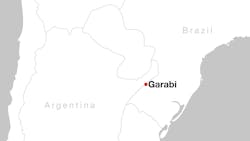Brazil's Taesa Commissions Upgrade of HDVC Converter Station
Taesa, one of Brazil’s largest private electric energy transmission groups, has commissioned Hitachi Energy for an extensive upgrade of the Garabi high-voltage direct current (HVDC) converter station in Brazil. The link can transmit up to 2,200 megawatts of electricity, making it a powerful “back-to-back” HVDC system.
The Garabi converter station enables power exchange between Argentina and Brazil, which is normally not possible as Argentina's power system operates at 50 Hz, and Brazil's operates at 60 Hz. The transmission system comprises 490 km (304 miles) of alternating current overhead lines between the substations in northern Argentina and southern Brazil and the HVDC converter station at Garabi in Brazil, near the border.
The station began full commercial operation in 2000 and, after more than 20 years of operation, the control and protection system will be upgraded with the latest MACH technology from Hitachi Energy, which provides unequaled calculation capacity and enables a high degree of integration and handling for all control and protection functions. This will be the first HVDC upgrade in Brazil and will secure the electricity supply for the future while increasing reliability and availability.
“Our mission is to connect Brazil with safe and reliable electricity, generating value for society and transmitting energy with excellence and quality,” said Emmanuel Pasqua de Moraes, expansion planning and engineering executive manager of Taesa. “Cross-border interconnections such as Garabi are a key part of that mission and this Hitachi Energy HVDC system is an important part of securing power for the Brazilian National Interconnected System and with international connections increasing the energy security of our system.”
HVDC systems are commonly used for large-scale transmission and exchange of electricity over large distances between two HVDC converter stations, but the Garabi HVDC converter station is a back-to-back system in a single location.1 Back-to-back stations utilize the sophisticated, digital controllability of an HVDC system to precisely manage the flow and properties of the electricity supply, providing many benefits for grid control and stability.

